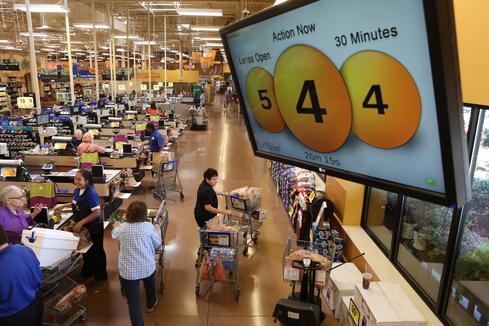Kroger Solves Top Customer Issue: Long LinesKroger Solves Top Customer Issue: Long Lines
The supermarket chain, No. 3 in the information Elite 100 ranking, uses QueVision system to ensure customers never have more than one person ahead of them.

What bugs people the most about grocery shopping? It's not the in-store Muzak or the occasional squished loaf of bread. It's the dreaded wait at the checkout line, according to Kroger customer surveys, prompting the supermarket chain to test a variety of technical solutions over the years. Kroger thinks it finally has the right mix of technology: QueVision, which combines infrared sensors over store doors and cash registers, predictive analytics, and real-time data feeds from point-of-sale systems.
From the moment customers walk through the door of a Kroger store, the QueVision technology works toward one goal: ensuring that they never have more than one person ahead of them in the checkout line. The technology, now deployed at more than 2,300 Kroger stores across 31 states, has cut the average wait time from more than four minutes to less than 30 seconds, the company says.
Kroger was doing data analytics simulations on the queuing problem as far back as 2007. "We asked a question: If we could open up a lane exactly when we needed it, what would happen?" says Doug Meiser, operations research manager. "We just wanted to ask the question from an analytics standpoint. And we found we could dramatically improve customer satisfaction." From there, he says, it became a matter of "the math is sound; how do we go do this?"
[For more information Elite 100 coverage and a complete listing of the top 100 companies click here.]
Sensors, meet analytics.
Brett Bonner, senior director of R&D at Kroger, says the key business metric is higher customer satisfaction levels. "We weren't interested in cutting [employee] hours," he says. "We were interested in a better shopping experience." Customer loyalty is especially key in the low-margin grocery business. (Kroger, with 2013 sales of $98.4 billion, operates throughout much of the US under various store names, including Ralph's and Harris Teeter.) "At the heart of loyalty is analytics," Bonner says. "We actually have a very long history with that."
Meiser's team did the discrete-event analysis, using a front-end simulator developed with Visual Thinking International. That simulator let the Kroger team adjust inputs such as store layout, staffing levels for cashiers and baggers, and historical transaction logs -- because factors such as time of day and time of month affect how people shop. Kroger's R&D group then partnered with Irisys, a maker of appliances and infrared sensors, to count customers entering the store and at checkout lanes.
Figure 1:  Kroger's QueVision system includes a display that keeps customers and
Kroger's QueVision system includes a display that keeps customers and
store staff informed about how checkout lines are moving.
The Kroger team combined its analytics-based forecasting tools and a tweaked version of the Irisys appliance to calculate the magic number of registers needed -- in real time and looking ahead 15 and 30 minutes.
Kroger already had custom reporting software (well-liked by managers because it was easy to use) that broke down key metrics by district and store, with the goal of "three mouse clicks to the store you're looking for," Meiser says. That software became the reporting back end for the new data on checkout wait times.
Kroger's R&D team began rolling out QueVision in select stores in 2010. Its retail operations team and store managers drove the project and enhanced it. "We had to install an enterprise system in a way that was seamless to the shopper," Bonner says. "That was a huge challenge. We spent about 18 months learning to do that. You just can't inflict an R&D system on a store."
The R&D team's original idea was to notify employees and managers of the wait-time data via handhelds. But a store manager's suggestion to
put the data up on a screen -- where everyone, including customers, could see wait times -- turned out to be key to the project's success.
The next act.
One unexpected bonus was that the shorter lines also improved another customer-oriented metric: the friendliness of associates.
Shoppers are happier when they have shorter lines, Bonner notes. "When the associates have happy shoppers, they are happier, too," he says. "The math did not predict happier associates." That cashier-friendliness metric, measured in customer surveys, has improved company-wide, rising 24% since 2011, Kroger says.
The reporting software has become key to continuing improvement, Meiser says. Everyone from store employees to executives can see daily metrics on how stores are doing on customer satisfaction. "That is the performance scorecard that everyone agrees is the absolute mission of the company," he says. "Everybody knows we will have a daily conversation to make it better."
Did the project change the way Kroger staffs its stores? While some retailers have used the Irisys appliances to cut labor hours, that wasn't part of Kroger's plan, Bonner says, so the company kept labor hours about the same. Store managers did gain more flexibility to schedule employee breaks and move employees to the floor to do other tasks, he says.
Kroger uses the QueVision data in more detailed simulations. It has correlated enough data to keep people moving in the front of stores, including checkout lines, even in stores with unusual layouts. The QueVision data also helps Kroger evaluate new shopping systems, such as ones that let customers scan their own products while shopping.
For its next act, the R&D team will roll out a project to improve food safety -- after a significantly shorter six-month development cycle, Bonner says. "We're going to monitor every case, every temperature in the Kroger company, real time," he says. "We believe in the Internet of things. We're not done."
What do Uber, Bank of America, and Walgreens have to do with your mobile app strategy? Find out in the new Maximizing Mobility issue of information Tech Digest.
About the Author
You May Also Like






